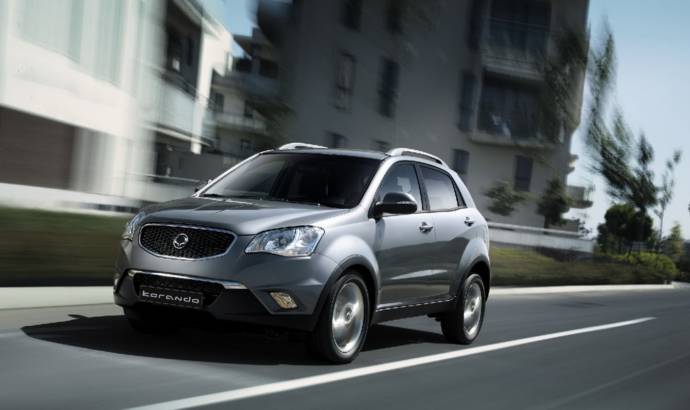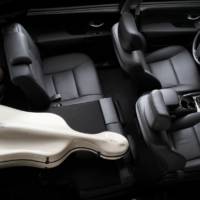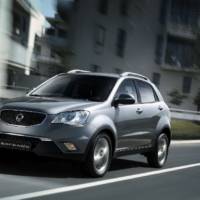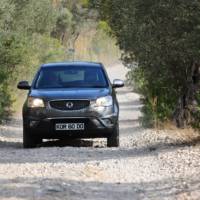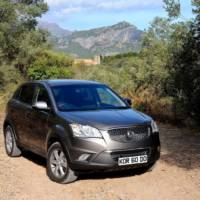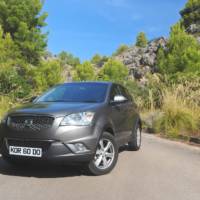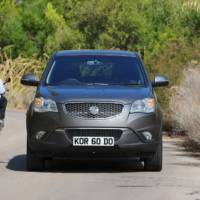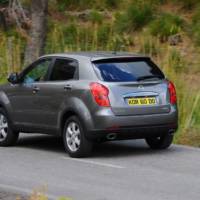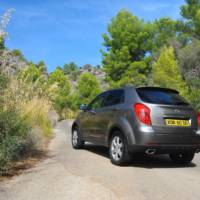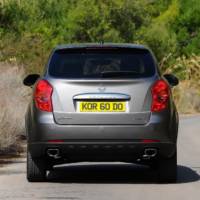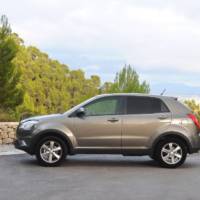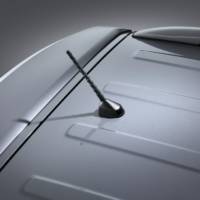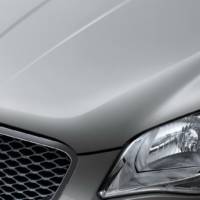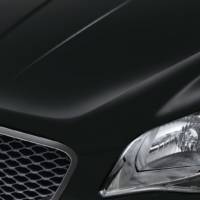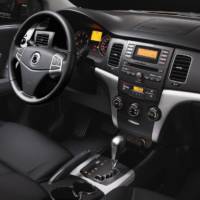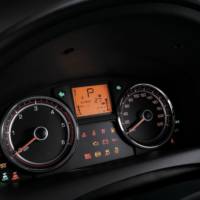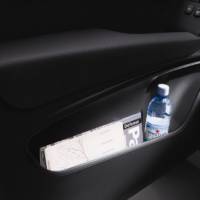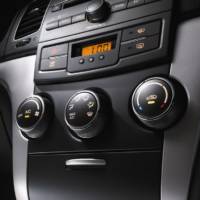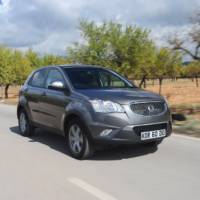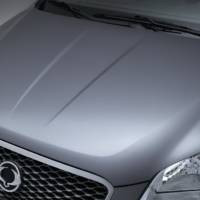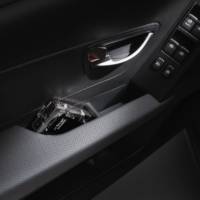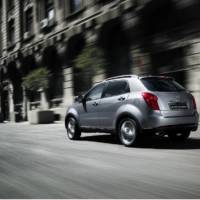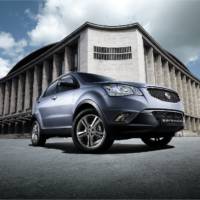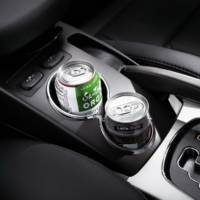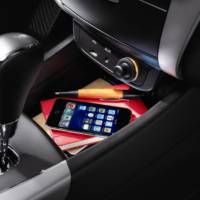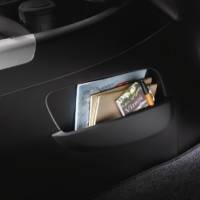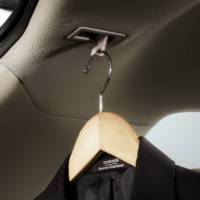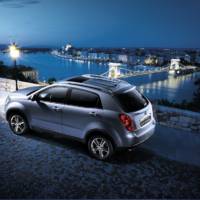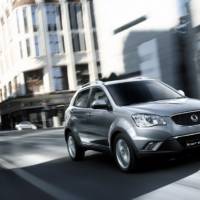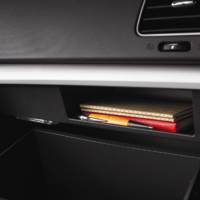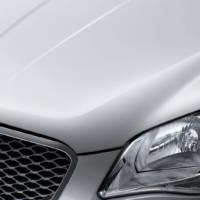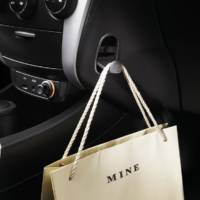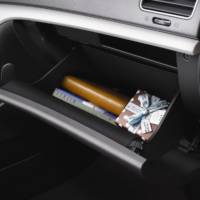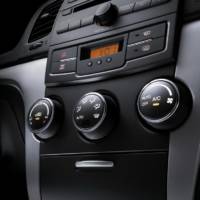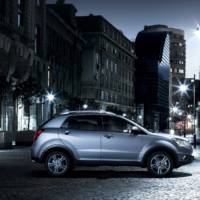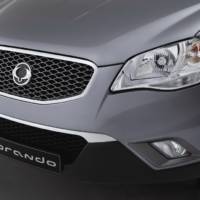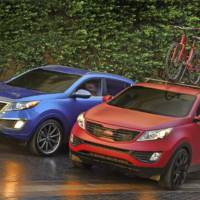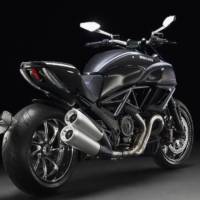The completely refreshed SsangYong Korando has been revealed, and besides being designed in Europe, the European bound crossover also features a new platform and a new engine.
The SsangYong Korando was designed by Giorgetto Giugiaro, and as you can see it now features a strong, charismatic aspect, with sharp lines that created a dynamic shape.
The SsangYong Korando will be offered with a choice between two-wheel or all-wheel-drive and power will get extracted from a 2.0-litre diesel which outputs 175 PS and requires 6.0
l/100km (47mpg). CO2 emissions are of only 157g/km and as far as transmission options, both 6-speed manual and 6-speed automatic gearboxes are available.
As far as equipment the new SsangYong Korando comes with mechanical features like a ESP, Hydraulic Brake Assist (HBA), Hill Start Assist (HSA), Active Roll-over Protection (ARP), Emergency Stop Signal (ESS) and Electric power steering (EPS) while at the interior customers will get automatic climate control, heated front and second row seats, leather upholstery and a 6-way power driver’s seat with lumbar support and which is also height adjustable.
The new SsangYong Korando also gets a generous list of safety and convenience features, all of which are details in the press release below the jump.
The SsangYong Korando price was not announced yet.
SsangYong Korando video :
SsangYong press release :
Crossover Korando – Reborn as a model designed in Europe to meet the needs of the European market
- All-new crossover model fresh from the ground up
- European design by Giorgetto Giugiaro
- SsangYong’s first monocoque construction provides the perfect basis for a modern crossover
- Choice of two-wheel drive or all-wheel drive
- 2.0-litre diesel engine blends efficient fuel economy and high performance
- Both manual and automatic transmissions available
- Low CO2 emissions will appeal to company car drivers
- Class leading towing capacity of two tonnes
New platform, new design, new engine – SsangYong’s new Korando brings an entirely fresh approach to the crossover market.
Introducing a number of significant firsts for SsangYong, the Korando
is ready to take a bold step into one of the most buoyant sectors of
the European car market. Merging the low running costs and dynamic
abilities of a conventional family hatchback with the visual appeal,
adventurous spirit and rough-road capability of an SUV, the Korando is
aimed at the heart of the crossover market.
With the focus on quality and desirability, the Korando has been
designed and jointly developed in Europe by renowned stylist Giorgetto
Giugiaro. With one of the most famous names in automotive design behind
it, the new Korando takes on a modern, stylish SUV shape reflecting the
rugged appeal that lies at the heart of today’s SsangYong Motor Company.
Looking outside of Europe, the Korando brand is already one of the
strongest in the SUV market. Indeed, Korando is listed in the Korean
Guinness Book of World Records as the country’s longest surviving
automotive brand. With its roots stretching as far back as 1974, the
Korando started a new chapter in Korean car making as the first-ever
self-developed four-wheel-drive model to come from the country in 1983.
The next significant evolution in 1996 was the adoption of Mercedes-Benz
diesel technology when the third generation model was introduced.
Now, after a five year absence from the world’s car market, Korando
is back in an all-new form to claim its place among the world’s new
C-segment SUV crossover models.
Epitomising today’s economic ethos of spending less without
compromising on quality, the Korando is perfectly placed to meet the
needs of downsizing drivers. The compact C-segment sized SUV market now
accounts for more than half of the total SUV market in Europe, and this
proportion is expected to grow in the coming months and years.
Designed and developed over the last five years to deliver the
environmentally conscious efficiency that’s expected of every class
leading crossover, the Korando offers high fuel economy and low CO2 emissions to rival the best in class.
Add the proven strength and safety that comes from the DNA of an SUV
specialist, and every need is met – environmentally friendly interior
materials, comfort, refinement, practicality and versatility all feature
to make the Korando a crossover that’s sure to stand out in a busy
marketplace.
The new powertrain – efficiency and performance combined
An all-new model deserves an all-new powertrain – and the Korando’s
new e-XDi200 engine is at the very heart of the crossover’s appeal. With
a high power output of 175PS, superb combined cycle fuel economy of 6.0
l/100km (47mpg) and CO2 emissions of only 157g/km the
Korando can challenge the very best rivals. Refinement is a key strength
of the new 2.0-litre diesel engine which is offered with both manual
and automatic six-speed transmissions to power both front and four-wheel
drive Korando models.
Furthermore, the Korando range will be extended next year with the
introduction of a new even more frugal diesel engine as well as a
high-value petrol unit.
Cabin comfort at the core of Korando design
Making the most of its commanding driving position, the Korando
offers superb cabin comfort and interior ergonomics. No matter what the
surface, a smooth ride quality has been achieved with the adoption of a
double bush type sub-frame mounted suspension system, while extensive
NVH engineering isolates occupants from external interruptions.
Specification that puts passenger safety first
Passenger safety comes first. Six airbags – dual front, side and
curtain – are fitted as standard, while there is also multi-function ESP
(Electronic Stability Program), which integrates anti-rollover
protection, brake assist, hill start assist and ESS (Emergency Stop
Signal). Other standard safety features include first row active head
restraints and ISOFIX.
Crossover to the Korando
The Korando is a model which has been designed to reaffirm
SsangYong’s position in the minds of the European car buyer. Far from
merely fulfilling the basic needs of the consumer, design innovations
have been offered to tempt buyers away from established competitors. The
eco cruise control system efficiently manages the amount of fuel
injected to maximise economy, a door mirror mounted LED puddle lamp
helps passengers get in and out safely and comfortably even in dark
areas and the Korando’s towing ability has been at the core of its
development from day one.
Recognising the desires of many drivers to stamp their personality on
their new car purchase, the Korando is offered with a choice of seven
exterior colours and a combination of interior shades and materials
including luxurious leather seats. Buyers also have the option of a
special interior specification which features a unique orange highlight
colour.
Korando will be revealed this autumn through the over 1,240 strong
SsangYong international dealer network before starting on its journey to
strengthen the SsangYong Motor Company’s brand. The first Korando
models will be delivered to UK buyers in January 2011, when the
following variants will be offered:
- Two-wheel drive, manual
- Two-wheel drive, manual – High Line
- Two-wheel drive, automatic – High Line
- All-wheel drive, manual – High Line
- All-wheel drive, automatic – High Line
STYLING & DESIGN
Styling concept
As one of Europe’s most respected designers, Giorgetto Giugiaro was
brought onboard from the early stages of development to position the
Korando perfectly into the competitive crossover market. The result is
an elegantly proportioned shape which is perfectly in-tune with the
design themes of the moment.
The strong, charismatic front end of the Korando sets the tone for
the sharp lines that punctuate the dynamic silhouette. Embodying the
SsangYong design theme of ‘elegance within strength’, the Korando brings
a fresh take on SUV styling to the crossover market.
Exterior design: robust aesthetics
When creating the fourth generation Korando, designers had strong
themes in mind. Conveying the strength and toughness of SsangYong’s SUV
building history with an adventurous spirit keen to explore both the
wild countryside and the urban jungle, the Korando’s crossover body took
shape.
The high bonnet line gives a sense of power and pays tribute to the
go-anywhere abilities of SsangYong SUVs, while the perfectly balanced
six-point radiator grille and angular headlamp shape are both poised and
athletic.
The two-tone bumper shape was designed to express the SUV’s stability
and toughness. This is complemented by the mesh radiator grille, bold
air intake and chrome trim to make a strong and powerful statement.
At the rear the design statements are equally bold. A defined line
runs from the front headlamp to the rear lamp cluster, following the
contours of the body and emphasising the Korando’s shape. The rear light
clusters have in-built lenses to appear completely red despite housing
the turn indicators and reversing lamps.
One of the key design characteristics of any Giorgetto Giugiaro
designed model is the perfect proportion. Study the Korando in profile
and you will see how this pillar of automotive design has been applied
to provide the optimum balance, with a beltline that begins as a
diagonal and finishes as a curve to emphasise the presence of both
toughness and speed.
The harmony of a neat glass area and the distinctive C-pillar shape
is the essence of the robust design that gives a sense of power to the
whole vehicle.
Adding visual strength to the Korando’s SUV shape, substantial
wheelarches draw the eye to the raised ride height. However, the arches
retain a utilitarian black finish to add to the feeling of robustness
that’s lacking in so many compact SUV models.
With its perfect proportions, toughness throughout and the attention
to detail achieved only by the finest automobile designers, the Korando
comes equipped with the very finest European design.
Interior design: premium space
The Korando’s interior combines the Oriental ethos of moderation and
elegance. The result is a cabin which uses subtle design detailing to
punctuate a spacious and practical interior which meets the needs of the
most demanding crossover buyer.
Central to the design of any automotive interior is the driving
environment. The Korando’s instrument panel is simple and elegant, with
two large dials separated by a digital display. A modern, uncluttered
control layout features chrome coloured trim to highlight the flowing
lines.
Particular attention has been paid to the look and feel of the main
cabin controls. The tactility of the dials and switches has been
developed to convey a feeling of quality and robustness in keeping with a
crossover model.
Of course, practicality hasn’t been forgotten either, with drinks
holders front and rear along with secure stowage spaces for everything
from portable music players to maps. The luxurious seats offer an added
dimension of versatility and comfort, with the option to fold the second
row flat to leave an even more practical luggage area.
With the Korando’s interior, designers have succeeded in maximising
space, comfort and practicality in a high quality, driver-centric cabin.
Colour design: the finishing touch
With the fundamentals of a class leading cabin design complete,
choosing the perfect colour palette was the finishing touch to the
Korando’s interior.
In order to satisfy diverse consumer needs, classy black and natural
beige form the basis of the key interior colours. Paying particular
attention to the young and active drivers for whom the crossover market
often holds most appeal, a special orange highlight colour can be added
to the black interior to add a sporty finish.
Just as important as colour is the material used to create each
interior part. The Korando cabin is trimmed with everything from
attractive chrome and metal accents to premium quality soft-touch
plastics. Anti-bacterial paint is also used to enhance the wellbeing of
occupants.
As for exterior colours, a total of seven tones are available including vibrant Vitamin Red and striking Ice Blue.
Performance
Leading the way with efficiency
- Low emissions, high performance: e-XDi200
The diesel engines used to power SsangYong models have long been one
of the marque’s key strengths. Combining the traditional virtues of high
performance and outstanding durability with superb economy and
refinement, the new e-XDi200 diesel engine is the perfect powerplant for
the Korando.
The 2.0-litre e-XDi200 engine provides a maximum power output of
175PS and peak torque of 360Nm, representing a 20 per cent improvement
over its predecessor. Optimum torque is delivered across a low yet broad
rev range of 2,000-3,000rpm, leading to effortless acceleration from
low engine speeds thanks to SsangYong’s E-VGT (Electric Variable
Geometry Turbocharger).
Not only is it fully compliant with Euro5 emissions regulations, but
the e-XDi200 engine is also designed to fulfil the requirements of the
future Euro6 rules. This has been achieved with the help of a range of
technological advancements including third generation 1,800 bar common
rail fuel injection, E-EGR (Electric Exhaust Gas Recirculation), swirl
control valve and CDPF (Catalysed Diesel Particulate Filter). The swirl
level has been made flexible for different gear ratios to achieve the
cleanest possible diesel combustion.
The result is highly frugal combined cycle fuel economy of 6.0 l/100km (47mpg) and CO2
emissions of only 157g/km. Such impressive efficiency can only be
achieved through the implementation of a range of measures throughout
the Korando’s design.
The SsangYong’s kerb weight is only 1,672kg (manual version) thanks
to various weight saving measures including the use of an oil separator
integrated plastic cylinder head cover. Lowering friction has also
played its part, with low tension piston rings, plateau honing and low
viscosity oil all helping to reduce energy losses.
Advanced engine control devices have also been developed including a
dual knock sensor and a system to optimise intake and fuel injection
according to driving conditions. A rapid temperature elevation warm-up
system is also in place to improve the engine’s performance in cold
start and warming-up situations.
Efficiency and performance are only two-thirds of a modern diesel
engine’s requirements – refinement is equally important. That’s why the
e-XDi200 engine minimises NVH (Noise, Vibration and Harshness) with
decoupling technology and an advanced balancing system to drastically
reduce booming noise in the mid to high speed range. The engine itself
has also been made quieter by acoustically tuning the layout of the
chain system to reduce unwanted noise.
The final test for any new engine is reliability, and the Korando’s
new powerplant has passed the Mercedes-Benz durability test with flying
colours. This is the world’s toughest examination for any new engine,
designed to test it to the limit before it is fitted under the bonnet of
a production model. The final seal of approval was given to the new
Korando’s engine only after it had also undergone extensive real-world
test driving in both the hottest and coldest of environments.
- AWD
To suit the needs, expectations and budget of all types of crossover
driver the Korando is offered in both front-wheel-drive and
all-wheel-drive (AWD) forms. While variants feeding power only to the
front wheels will offer the lowest price entry into Korando ownership,
SsangYong’s advanced AWD system makes the most of the model’s dynamic
abilities both on and off road.
The Korando’s AWD is an on-demand system. By monitoring the grip
level, the technology can determine the driving conditions and traction
available before distributing power to the wheels that need it most.
Under normal driving conditions 100 per cent of the engine’s torque
is driving the front wheels so that the Korando can run with the
efficiency of a family hatchback. However, as soon as the front tyres
begin to lose traction, power is fed to the rear wheels to ensure safe,
stable and dependable progress is resumed. The technology also comes
into play when pulling away on a steep slope, allowing the Korando to
drive off from a standstill smoothly and safely every time.
What’s more, the AWD even has a special in-built self-protecting
function. If a driver fits a different type of tyre or has extreme
differences in wear between front and rear tyres, the driving power
going to the rear is reduced to prevent any damage to the transmission.
Calling on its 4×4 know-how, SsangYong hasn’t forgotten that many
Korandos will find their way off the beaten track on a wintery adventure
or towing a caravan on a sodden campsite. That’s why engineers have
fitted an AWD lock mode to manually force the spread of power between
the front and rear wheels at speeds below 25mph.
All this only adds to the Korando’s credentials as a class leading
towing vehicle. The SsangYong has been engineered to pull a braked
trailer weighing as much as 2,000 kg, while an unbraked trailer of 750
kg also poses no problems. Keen caravaners have already been impressed
by the Korando’s statistics, and are sure to fall for its all-round
abilities with a load in tow on the road.
With or without a trailer, at the core of the AWD Korando’s
engineering is safety. When working with ESP (Electronic Stability
Program) and ABS (Anti-lock Braking System), the four-wheel-drive system
provides the best possible grip and control whatever the conditions.
- Transmission
Surpassing many of its rivals, the Korando offers a choice of two six-speed transmissions to crossover drivers.
In the UK the six-speed manual transmission is expected to be fitted
to the majority of Korando models. Using a wide spread of ratios, the
gearbox has been developed to improve launch acceleration while also
offering low-engine-speed high-economy running at motorway pace.
Efficiency and durability have also been improved by optimising oil
lubrication, while particular engineering attention has been paid to
reducing gear whine at all speeds.
Unlike many of its rivals, choosing the Korando’s automatic
transmission doesn’t mean giving up any gear ratios. The six-speed auto
takes the same wide-ratio spread approach as the manual to minimise its
impact on economy, emissions and refinement. Drivers can also take
manual control at any point using the shift lever or steering wheel
mounted switches.
Technologies such as variable solenoid control, fully adaptive input
control and electronic shifting have been used to automatically detect
how the driver wants the gearbox to operate. Shift refinement has also
been at the forefront of the transmission’s development along with
efficiency. Just like every other aspect of the Korando’s mechanical
systems, the transmission suffers minimal power and friction losses
thanks to the use of variable line pressure control and low viscosity
ATF (Automatic Transmission Fluid).
- Suspension & Running Gear
The new crossover Korando uses a combination of technologically
advanced systems and engineering to achieve optimal driving performance
and minimise Noise Vibration and Harshness (NVH). Details of each
system/area can be found below.
- EPS (Electric Power assisted Steering)
SsangYong’s EPS uses an electric motor to provide the perfect amount
of assistance to the driver when turning the wheel. The system is speed
sensitive, offering maximum assistance during parking manoeuvres and
greater feel out on the open road. A further advantage is improved
efficiency over traditional hydraulic power steering systems.
- Optimal Ride & Handling
To compliment SsangYong’s first monocoque construction, compact
sub-frames are installed at the front and rear. This not only provides
ride and handling characteristics much closer to a conventional road car
rather than an off-roader, but it also dramatically improves the
cabin’s insulation from bumps and ridges in the road. At the front, side
load springs are used to minimise friction and in turn improve both
noise levels and durability. Coil springs are fitted to the rear
sub-frame to improve overall driving comfort. Extensive engineering
development has gone into the blocking of any sub-frame leaning when
cornering, helping the Korando to maintain a flat, neutral stance.
- Drive Shaft
The drive shaft sends power to the AWD system and normally consists
of steel tubes and universal joints. However, this set-up didn’t measure
up to the high standards of NVH expected of the Korando. Instead, a
constant velocity joint and rubber couple is used, achieving lower noise
levels at high, constant speeds. What’s more, this set-up reduces shock
and vibration when cornering, further improving refinement and comfort.
- Sound Insulation Optimisation
Another further improvement in the comfort and enjoyment of every
drive is the reduction in sound entering the cabin. Heavy-layer and
polyurethane sound absorbing/blocking materials have been used both
behind the dashboard and under the floor to minimise any intrusive
noise. Further sound insulation is also provided by a felt material
fitted between the engine and the cabin, while a final layer of sound
absorbing material is fitted to the dashboard.
- Off-Road Capacity
While the Korando is more at home on the tarmac than ever before,
off-road capability hasn’t been sidelined. The Korando has a ground
clearance of 180mm, approach angle of 22.8 degrees, departure angle of
28.2 degrees and ramp angle of 18.5 degrees. The result is a maximum
climb angle of 48 per cent (AWD, 33 per cent for 2WD), a roll over angle
of over 40 per cent and a wading depth of 300mm.
These statistics give the crossover model the sort of off-road
ability that goes far beyond the expectations of many drivers, but which
allows rough tracks and steep inclines to be tackled without costly
body or mechanical damage.
SAFETY
Active & Passive Safety System: Secure safety through optimal chassis structure and state-of-the-art technology
One of the main attractions of an SUV is the feeling of safety and
security afforded by a high driving position and robust body. The
challenge with a crossover model is to offer genuine advances in safety
without suffering the penalties of increased weight and reduced
efficiency which afflict traditional off-roaders.
In order to meet the demands of the most safety-conscious crossover
buyer, the Korando has an energy multi-dispersion structure which
channels the force of a front-end impact to the vehicle body through
three load channels, including the front sub-frame. This spreads the
energy from a crash to minimise the forces felt by passengers and any
resultant injuries.
In the case of a rear-end impact, a crash box made from high-tension
steel acts as a buffer, absorbing crash energy together with the rear
bumper to protect vehicle occupants. Both front and rear-end structures
have also been designed to minimise the potential danger to pedestrians.
With many Korando buyers likely to have a young family, the addition
of the international standard ISOFIX car seat mounting system is a vital
feature, allowing child seats to be installed easily and securely every
time.
While some rivals might charge extra for vital safety equipment, the
Korando comes as standard with the full complement of six airbags. Dual
airbags are fitted for the driver and front passenger, while side and
curtain airbags will deploy in the event of a side-on crash. There is
also a state-of-the-art safety restraint system in place to stop
passengers from being thrown out of the car in a rollover accident.
Another safety enhancement comes in the shape of the latest active
head restraint system. An electric signal is detected by the sensor in
the event of a rear-end crash and instantly moves the front head
restraints forwards and upwards to reduce any potential neck injuries.
However, there’s more to safety than merely considering the
worst-case-scenario high speed impact – slow speed accidents also
require engineering development to minimise repair bills and insurance
costs. A high tension steel crash box is installed at both the front and
the rear to reduce the damage caused by low-speed bumps. The design
enables easy repairs to be carried out to vehicles which have absorbed
collision energy into their crash boxes rather than costly chassis and
body parts.
While reducing the consequences of an accident was at the core of the
new Korando’s development, helping drivers to avoid collisions in the
first place was equally important. The newly developed ABS/ESP system
compares the driver’s inputs to the steering, throttle and braking with
the vehicle’s status and controls the engine, transmission and braking
systems to ensure maximum possible safety in every instance. The system
can even detect an abnormal situation, for example when the accelerator
and brake pedals are accidentally pressed at the same time, and operate
an override function in which the engine will return to idle to help
prevent any potential accidents.
What’s more, the Korando’s ESP system also works along with HBA
(Hydraulic Brake Assist) to apply the maximum braking force in an
emergency, decreasing stopping distances when the driver isn’t able or
experienced enough to apply full pressure to the brake pedal. ARP (Anti
Rollover Protection) provides further driver assistance by preventing
instability during sudden changes of direction. To make pulling away on a
slope easier and safer HSA (Hill Start Assist) is also fitted, while
ESS (Emergency Stop Signal) warns following vehicles of emergency stops
and ABS activation.
COMFORT & CONVENIENCE
All the comfort of an SUV with the convenience of a family hatchback
Despite having dimensions compact enough to fit into the city, the
Korando offers the practicality required of a family car. Its wide
interior offers the practicality of an SUV with the proportions and
running costs of a conventional compact family hatchback, making the
Korando the perfect transport for both everyday use and leisure
activities.
The convenience begins in the driver’s seat. Various storage spaces
are available including a centre fascia tray, a door pull handle tray
and a large map pocket. The prominent digital read-out also gives the
driver all the information they need when heading out into the great
outdoors for a spot of mountain biking or canoeing, including both
external and internal temperature and humidity. This trip computer also
displays information about fuel consumption and range capability.
Over on the passenger side, the glove box contains a partition tray
and a credit card holder, while there’s also the added convenience of a
hook to secure a carrier bag.
The Korando’s wide track ensures that passengers will be comfortable
whether they are sitting in the front or the rear. Those in the back
benefit from a flat floor without an intrusive transmission tunnel,
while the second row seats can be split 60:40, fold & dive and
recline to provide various seat variations.
Lift the Korando’s tailgate and you’ll find a spacious 486 litre
luggage area complete with a large under-floor tray. The luggage cover
is also removable, while a hanger on the roof and a hook to fix a load
net add to the SsangYong’s practicality.
With a level of convenience normally only offered by premium saloons,
the Korando provides plenty of attractive features. Top of the list for
many will be the standard fit Bluetooth audio system, which not only
allows calls to be made and received via a Bluetooth enabled mobile
phone but also provides the ability to stream music via a suitable
device.
When the driver uses the remote key fob to unlock the vehicle, both
the interior and door mirror mounted puddle lights are illuminated to
light the way. Both are also lit automatically when the driver removes
the key from the ignition and opens the door.
Other convenience features include automatically folding/unfolding
mirrors, which are operated when the doors are locked/unlocked using the
remote key.
When the Korando reaches 18.6mph (30km/h) the doors are automatically
locked, but in a crash situation in which the airbags are deployed, the
locked doors will automatically unlock, the interior light will turn on
and the hazard lights will be activated.
Looking after the wellbeing of occupants is at the core of the
Korando’s cabin design. That’s why various switches have been treated
with paint that prohibits the growth of microbes to prevent the spread
of germs.
Security is also assured thanks to a standard fit alarm and immobiliser.
EQUIPMENT
Mechanical
- 175PS 2.0-litre e-XDi200 diesel engine with CDPF
- Active AWD
- Six-speed manual transmission
- Six-speed automatic transmission with manual mode
- McPherson strut front suspension
- Multi-link rear suspension
- Electronic Stability Program (ESP) with Hydraulic Brake Assist
(HBA), Hill Start Assist (HSA), Active Roll-over Protection (ARP) and
Emergency Stop Signal (ESS) - Electric power steering (EPS)
Seats
- Six-way power driver’s seat
- Height adjustable driver’s seat
- Lumbar support for driver’s seat
- 60:40 split folding second-row seats with folding centre armrest
- Leather upholstery
- Woven cloth upholstery
- Heated front and second row seats
Climate control
- Fully automatic air conditioning with temperature sensor and outside temperature gauge
- Manual air conditioning with maximum air conditioning function
- Rear heating duct to enhance climate control effectiveness
- PTC (Positive Temperature Coefficient) heater
Appearance
- Chrome coated radiator grille
- All-around tinted glass
- Solar controlled windshield glass
- Privacy glass (rear door windows and tailgate window)
- Roof rails
- Rear spoiler with LED high mounted stop lamp
- Acoustic engine cover to dampen noise
- 18-inch hyper silver coated alloy wheels with 225/55 tyres
- 17-inch alloy wheels with 225/60 tyres
- 16-inch alloy wheels with 215/65 tyres
- Illuminated ignition key slot
- Leather steering wheel trim
- Floor mats
- Door mirror mounted puddle light
- Two-tone lower mouldings
- Chrome plated dual tail pipe
- Body coloured door handles
Convenience
- LED side repeaters on door mirrors
- Battery saver
- Electronic ECO cruise control
- Electronically-tuned AM/FM stereo audio system with MP3 CDP
- USB memory slot and Aux port
- RDS and Bluetooth system
- Pole aerial on the rear roof
- Auto-levelling headlights
- Windshield wiper de-icer
- Rain sensing wiper and automatic headlight activation
- One-touch triple signal indicators
- Heated tailgate window with timer
- Safety power sunroof that slides or tilts, with blind panel
- Power windows with safety (anti-trap) feature
- Remote keyless entry system with panic alarm
- Six speakers including two tweeters for high level sound
- Steering wheel audio system controls
- Dual spray type washer nozzles
- Trip computer
- 12V DC power outlets under the instrument panel and in the load area
- External door mirrors that can be electrically adjusted, folded and heated
- Mobile ashtray
- Digital clock
- Dual gas filled struts for tailgate
- Centre storage console
- Grip on the inside of the tailgate to facilitate closing
- Cupholders in the front and rear
- Sun visors with illuminated vanity mirror
- Luggage cover and net
- Toolbox in the load area
- Electrically operated tailgate release switch
- Manual tilt and telescopic steering wheel
- Tray on the upper instrument panel
Safety
- Monocoque body structure
- Door impact beams for optimal protection from side collisions
- Dual airbags in front with seatbelt load limiters and pre-tensioner
- Curtain airbags for front and rear passengers
- Side airbags for front passengers
- Active head restraints for front passengers
- Rear obstacle warning system with three-stage alarm
- 4-channel anti-lock braking system
- Front ventilated disc brakes
- Rear disc brakes
- Emergency Stop Signal (ESS)
- Door courtesy lamps
- Immobiliser system
- Rear wiper and washer
- Hand-operated parking brake
- Childproof safety lock
- Speed-sensing door lock
- Reminder alarm and speed-sensing feature for front passenger seatbelts
- Rear three-point seatbelts
- ISOFIX and tether anchorage for child seat
- Electrochromic rear-view mirror
TECHNICAL SPECIFICATIONS
Crossover Korando
Body & Chassis
Five-door, five-seat crossover, with all-steel unitary construction bodyshell.
Transversally-mounted diesel engine driving the front (2WD) or front
and rear wheels (AWD) via a six-speed manual or six-speed automatic
transmission.
| Engines | ||
| 2.0-litre / 175PS Diesel [ Available from launch ] | ||
| Name / Type | e-XDi200 / DOHC, four-cylinder in line, with E-VGT | |
| Capacity | 2.0-litre, 1,998 cc | |
| Max power | 175PS (129 kW) @ 4,000 rpm | |
| Max torque | 360Nm (36.7 kg.m) @ 2,000-3,000 rpm | |
| Fuel system | Common-rail, high pressure, direct injection | |
| Turbo system | Electric Variable geometry turbocharger (E-VGT) | |
| Emissions class | Euro55 | |
| Transmissions | ||
| 2.0D | ||
| Manual | 6-speed | |
| Automatic | 6-speed | |
| Drivetrains | ||
| 2.0D MT/AT | ||
| 2WD | S / O | |
| AWD | O / O | |
| S = available as standard | ||
| 2WD | ||
| Delivers 100 per cent of torque to the front wheels. | ||
| Safety aided by electronic Traction Control, ABS anti-lock braking and ESP with Active Roll-over Protection and Hill Start Assist Control. |
||
| AWD | ||
| Full-time on demand electronically controlled single ratio (High) system delivers 100 per cent of torque to front wheels during normal road driving. Manually selected ‘Lock Mode’ transfers higher torque to rear axle than 4WD ‘Auto Mode’ for enhanced stability during slippery conditions (under 25mph). |
||
| Suspension & Damping | ||
| Front | Fully independent by sub-frame-mounted MacPherson Struts, with coil springs and gas-filled shock absorbers. Anti-roll stabiliser bar. |
|
| Rear | Fully independent by sub-frame-mounted multi-links, coil springs and gas-filled shock absorbers. Anti-roll stabiliser bar. | |
| Steering | ||
| Type | EPS, electric power-assisted rack and pinion | |
| Overall ratio | 14.8:1 | |
| Gearing | 2.88 turns lock-to-lock | |
| Turning circle | 10.9 metres | |
| Brakes | ||
| Power | Tandem eight- & nine-inch booster | |
| Front | 294 x 26 mm ventilated discs | |
| Rear | 262 x 10 mm (2WD) / 284 x 10 mm (AWD) solid discs | |
| Parking brake | Hand operated lever | |
| ABS | Four-channel anti-lock system with EBD | |
| ESC | Electronic Stability Control | |
| ARP | Active Rollover Protection | |
| HBA | Hydraulic Brake Assist | |
| HSA | Hill Start Assist | |
| ESS | Emergency Stop Signal | |
| Wheels & Tyres | ||
| Standard | Alloy 16 in x 6.5J | 215/65 R16 tyres (Silica) |
| Options | Alloy 17 in x 6.5J | 225/60 R17 tyres (Silica) |
| Alloy 18 in x 6.5J | 225/55 R18 tyres (Silica) | |
| Spare (Standard) | Tyre mobility kit | |
| Spare (Option) | Space saver steel wheel and tyre | |
| Dimensions | ||
| Exterior (mm) | ||
| Overall Length | 4,410 | |
| Overall width | 1,830* | |
| Overall height | 1,675** | |
| Wheelbase | 2,650 | |
| Front track | 1,573 | |
| Rear track | 1,558 | |
| Front overhang | 920 | |
| Rear overhang | 840 | |
| Ground clearance | 180 | |
| *excluding door mirrors / **excluding roof rack | ||
| Interior (mm) | Front | Rear |
| Headroom | 1,010 | 990 |
| Legroom | 1,035 | 940 |
| Shoulder room | 1,450 | 1,410 |
| Hip room | 1,365 | 1,340 |
| Capacities | ||
| Fuel Tank | 57 litres | |
| Luggage (VDA) | 486 litres (behind rear seats) | |
| Off-road Capabilities | ||
| Approach angle | 22.8 degree | |
| Departure angle | 28.2 degree | |
| Ramp over angle | 18.5 degree | |
| Roll over angle | 40 per cent | |
| Max climb angle | 48 per cent(AWD), 33 per cent(2WD) | |
| Wading depth | 300mm | |
| Towing Capabilities (kg) | ||
| Max Towing Capacity (Braked trailer) | 2,000 | |
| Max Towing Capacity (Unbraked trailer) | 750 | |
| Max Tongue (Ball) Weight | 92 | |
| Weights (kg) | ||
| 2.0D MT/AT | ||
| All-wheel drive | ||
| Kerb weight (min.) | 1,672 / 1,692 | |
| Gross weight | 2,260 / 2,260 | |
| Two-wheel drive | ||
| Kerb weight (min.) | 1,591 / 1,611 | |
| Gross weight | 2,180 / 2,180 | |
| Performance | ||
| 2.0D MT/AT | ||
| All-wheel drive | ||
| Top speed (kph) | 179 (195) / 186 | |
| Top speed (mph) | 111 (121) / 115 | |
| 0-100 kph (62mph)(sec) | 10.0 / 10.8 | |
| Two-wheel drive | ||
| Top speed (kph) | 179 (195) / 186 | |
| Top speed (mph) | 111 (121) / 115 | |
| 0-100 kph (62mph)(sec) | 10.0 / 10.8 | |
| Fuel Economy (litres/100 km) | ||
| 2.0D MT/AT | ||
| All-wheel drive | ||
| Combined cycle | 6.4 / 7.5 | |
| CO2 g/km | 169 / 199 | |
| Two-wheel drive | ||
| Combined cycle | 6.0(*6.1) / 7.3 | |
| CO2 g/km | 157(*159) / 194 | |
| * Level 2 (Higher Option than Level 1 | ||
Source: SsangYong

